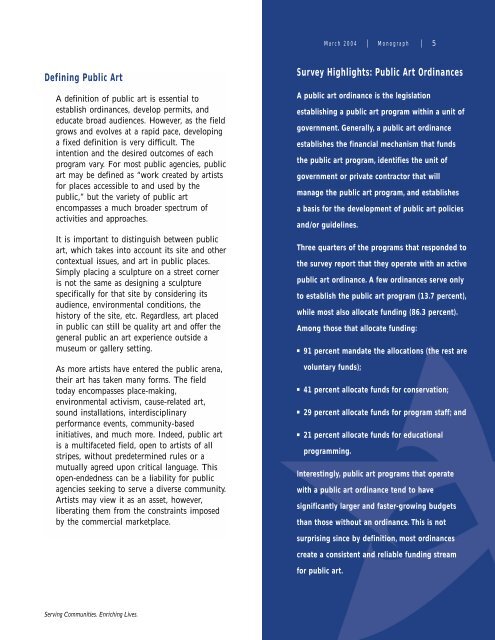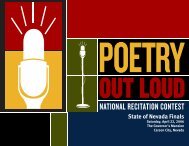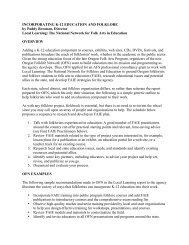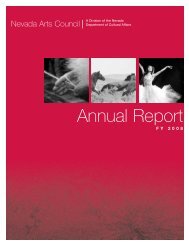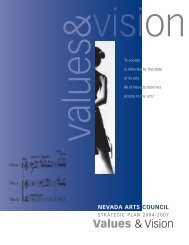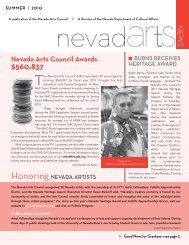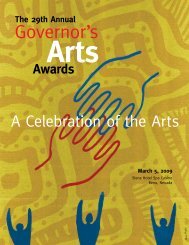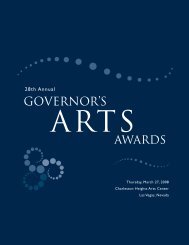Public Art - Nevada Arts Council
Public Art - Nevada Arts Council
Public Art - Nevada Arts Council
You also want an ePaper? Increase the reach of your titles
YUMPU automatically turns print PDFs into web optimized ePapers that Google loves.
March 2004 | Monograph | 5<br />
Defining <strong>Public</strong> <strong>Art</strong><br />
A definition of public art is essential to<br />
establish ordinances, develop permits, and<br />
educate broad audiences. However, as the field<br />
grows and evolves at a rapid pace, developing<br />
a fixed definition is very difficult. The<br />
intention and the desired outcomes of each<br />
program vary. For most public agencies, public<br />
art may be defined as “work created by artists<br />
for places accessible to and used by the<br />
public,” but the variety of public art<br />
encompasses a much broader spectrum of<br />
activities and approaches.<br />
It is important to distinguish between public<br />
art, which takes into account its site and other<br />
contextual issues, and art in public places.<br />
Simply placing a sculpture on a street corner<br />
is not the same as designing a sculpture<br />
specifically for that site by considering its<br />
audience, environmental conditions, the<br />
history of the site, etc. Regardless, art placed<br />
in public can still be quality art and offer the<br />
general public an art experience outside a<br />
museum or gallery setting.<br />
As more artists have entered the public arena,<br />
their art has taken many forms. The field<br />
today encompasses place-making,<br />
environmental activism, cause-related art,<br />
sound installations, interdisciplinary<br />
performance events, community-based<br />
initiatives, and much more. Indeed, public art<br />
is a multifaceted field, open to artists of all<br />
stripes, without predetermined rules or a<br />
mutually agreed upon critical language. This<br />
open-endedness can be a liability for public<br />
agencies seeking to serve a diverse community.<br />
<strong>Art</strong>ists may view it as an asset, however,<br />
liberating them from the constraints imposed<br />
by the commercial marketplace.<br />
Survey Highlights: <strong>Public</strong> <strong>Art</strong> Ordinances<br />
A public art ordinance is the legislation<br />
establishing a public art program within a unit of<br />
government. Generally, a public art ordinance<br />
establishes the financial mechanism that funds<br />
the public art program, identifies the unit of<br />
government or private contractor that will<br />
manage the public art program, and establishes<br />
a basis for the development of public art policies<br />
and/or guidelines.<br />
Three quarters of the programs that responded to<br />
the survey report that they operate with an active<br />
public art ordinance. A few ordinances serve only<br />
to establish the public art program (13.7 percent),<br />
while most also allocate funding (86.3 percent).<br />
Among those that allocate funding:<br />
■<br />
■<br />
■<br />
■<br />
91 percent mandate the allocations (the rest are<br />
voluntary funds);<br />
41 percent allocate funds for conservation;<br />
29 percent allocate funds for program staff; and<br />
21 percent allocate funds for educational<br />
programming.<br />
Interestingly, public art programs that operate<br />
with a public art ordinance tend to have<br />
significantly larger and faster-growing budgets<br />
than those without an ordinance. This is not<br />
surprising since by definition, most ordinances<br />
create a consistent and reliable funding stream<br />
for public art.<br />
Serving Communities. Enriching Lives.


